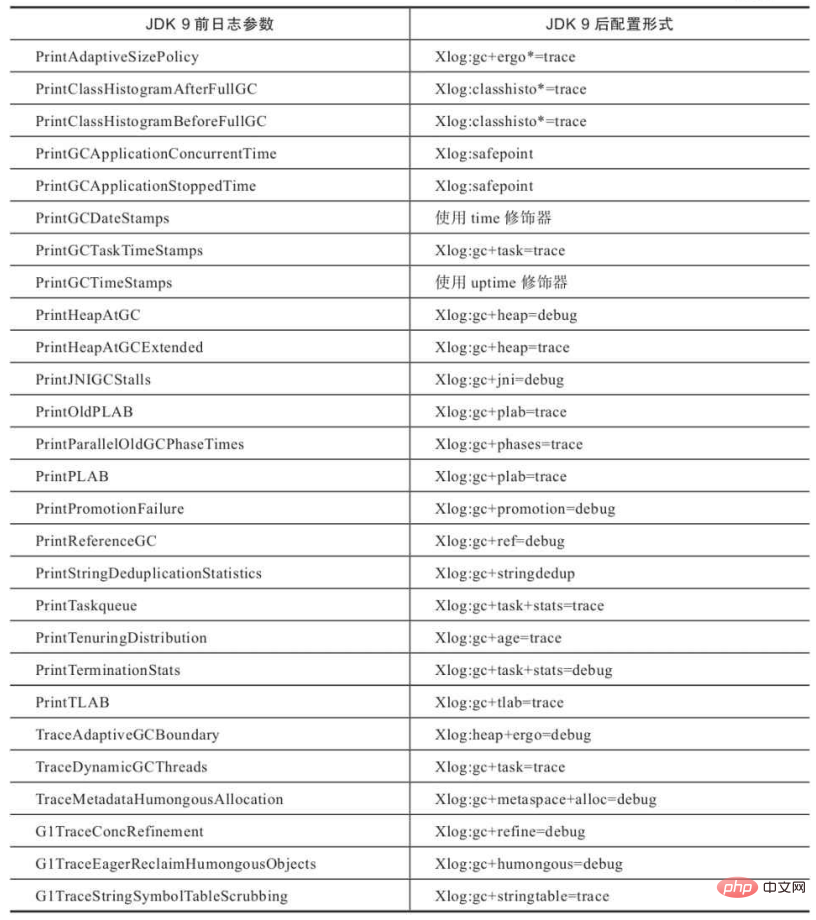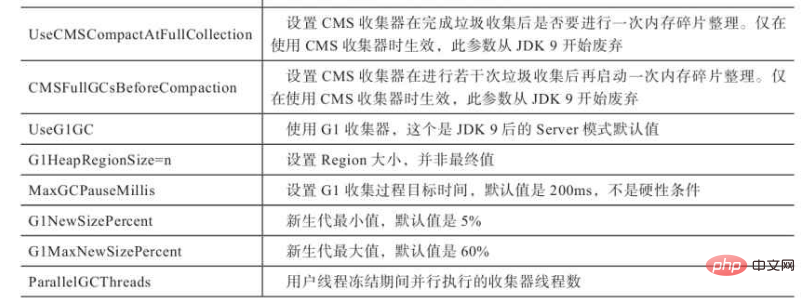 Java
Java
 javaTutorial
javaTutorial
 Java memory management: detailed explanation of allocation and recycling strategies
Java memory management: detailed explanation of allocation and recycling strategies
Java memory management: detailed explanation of allocation and recycling strategies


Table 3-4 Common parameters related to garbage collection plus -XX: UseSerialGC



Conceptually, the memory allocation of objects should be allocated on the heap (in fact, it may also be dismantled into scalar type and allocated indirectly on the stack[1]). Under the classic generation design, new objects are usually allocated in the young generation. In rare cases (for example, the object size exceeds a certain threshold), they may also be allocated directly in the old generation. The rules for object allocation are not fixed. The "Java Virtual Machine Specification" does not stipulate the creation and storage details of new objects. This depends on which garbage collector the virtual machine is currently using and the memory-related functions in the virtual machine. Parameter settings.
Objects are allocated in Eden first
In most cases, objects are allocated in the new generation Eden area. When the Eden area does not have enough space for allocation, the virtual machine will initiate a Minor GC.
Large objects enter the old generation directly
Large objects refer to Java objects that require a large amount of continuous memory space. The most typical large objects are those with very long characters. String, or array with a large number of elements. The byte[] array in the examples in this section is a typical large object. Large objects are outright bad news for the memory allocation of virtual machines. The worse news than encountering a large object is encountering a group of "short-lived large objects" that "live and die". We write programs Care should be taken to avoid this.
The reason why large objects should be avoided in the Java virtual machine is that when allocating space, it can easily cause garbage collection to be triggered in advance when the memory clearly still has a lot of space, in order to obtain enough continuous space to place them properly. , and when copying objects, large objects mean high memory copy overhead. The HotSpot virtual machine provides the -XX: PretenureSizeThreshold parameter, which specifies that objects larger than the set value are directly allocated in the old generation. The purpose of this is to avoid copying back and forth between the Eden area and the two Survivor areas, resulting in a large number of memory copy operations.
-XX: The PretenureSizeThreshold parameter is only valid for the two new generation collectors, Serial and ParNew. HotSpot's other new generation collectors, such as Parallel Scavenge, do not support this parameter. If you must use this parameter for tuning, consider the collector combination of ParNew and CMS.
Long-term surviving objects will enter the old ageThe virtual machine defines an object age (Age) counter for each object, which is stored in the object header. After a Minor GC, the age increases by 1 year. When its age increases to a certain degree (default is 15), it will be promoted to the old generation. The age threshold for an object to be promoted to the old generation can be set through the parameter -XX: MaxTenuringThreshold.
Dynamic object age determination
In order to better adapt to the memory conditions of different programs, the HotSpot virtual machine does not always require that the age of the object must reach -XX: MaxTenuringThreshold In order to be promoted to the old generation, if the sum of the sizes of all objects of the same age in the Survivor space is greater than half of the Survivor space, objects whose age is greater than or equal to this age can directly enter the old generation without waiting for the age required in -XX: MaxTenuringThreshold.
Space allocation guarantee
Before Minor GC occurs, the virtual machine must first check whether the maximum available continuous space in the old generation is greater than the total space of all objects in the new generation. If this If the conditions are met, then Minor GC can ensure safety this time. If it is not established, the virtual machine will first check whether the setting value of the -XX: HandlePromotionFailure parameter allows guarantee failure (Handle Promotion Failure); if it is allowed, it will continue to check whether the maximum available continuous space in the old generation is greater than the average value of objects promoted to the old generation. If the size is greater than the size, a Minor GC will be attempted, although this Minor GC is risky; if it is less than the size, or the -XX: HandlePromotionFailure setting does not allow risk, then a Full GC will be performed instead. After JDK 6 Update 24, the test results are different. The -XX: HandlePromotionFailure parameter will no longer affect the space allocation guarantee strategy of the virtual machine. Observe the source code changes in OpenJDK (see code list 3 -12), although the -XX: HandlePromotionFailure parameter is also defined in the source code, it is no longer used in the actual virtual machine. The rules after JDK 6 Update 24 become that as long as the continuous space of the old generation is greater than the total size of the new generation objects or the average size of previous promotions, Minor GC will be performed, otherwise Full GC will be performed.
The above is the detailed content of Java memory management: detailed explanation of allocation and recycling strategies. For more information, please follow other related articles on the PHP Chinese website!

Hot AI Tools

Undresser.AI Undress
AI-powered app for creating realistic nude photos

AI Clothes Remover
Online AI tool for removing clothes from photos.

Undress AI Tool
Undress images for free

Clothoff.io
AI clothes remover

Video Face Swap
Swap faces in any video effortlessly with our completely free AI face swap tool!

Hot Article

Hot Tools

Notepad++7.3.1
Easy-to-use and free code editor

SublimeText3 Chinese version
Chinese version, very easy to use

Zend Studio 13.0.1
Powerful PHP integrated development environment

Dreamweaver CS6
Visual web development tools

SublimeText3 Mac version
God-level code editing software (SublimeText3)

Hot Topics
 Java Spring Interview Questions
Aug 30, 2024 pm 04:29 PM
Java Spring Interview Questions
Aug 30, 2024 pm 04:29 PM
In this article, we have kept the most asked Java Spring Interview Questions with their detailed answers. So that you can crack the interview.
 Break or return from Java 8 stream forEach?
Feb 07, 2025 pm 12:09 PM
Break or return from Java 8 stream forEach?
Feb 07, 2025 pm 12:09 PM
Java 8 introduces the Stream API, providing a powerful and expressive way to process data collections. However, a common question when using Stream is: How to break or return from a forEach operation? Traditional loops allow for early interruption or return, but Stream's forEach method does not directly support this method. This article will explain the reasons and explore alternative methods for implementing premature termination in Stream processing systems. Further reading: Java Stream API improvements Understand Stream forEach The forEach method is a terminal operation that performs one operation on each element in the Stream. Its design intention is
 PHP: A Key Language for Web Development
Apr 13, 2025 am 12:08 AM
PHP: A Key Language for Web Development
Apr 13, 2025 am 12:08 AM
PHP is a scripting language widely used on the server side, especially suitable for web development. 1.PHP can embed HTML, process HTTP requests and responses, and supports a variety of databases. 2.PHP is used to generate dynamic web content, process form data, access databases, etc., with strong community support and open source resources. 3. PHP is an interpreted language, and the execution process includes lexical analysis, grammatical analysis, compilation and execution. 4.PHP can be combined with MySQL for advanced applications such as user registration systems. 5. When debugging PHP, you can use functions such as error_reporting() and var_dump(). 6. Optimize PHP code to use caching mechanisms, optimize database queries and use built-in functions. 7
 TimeStamp to Date in Java
Aug 30, 2024 pm 04:28 PM
TimeStamp to Date in Java
Aug 30, 2024 pm 04:28 PM
Guide to TimeStamp to Date in Java. Here we also discuss the introduction and how to convert timestamp to date in java along with examples.
 Java Program to Find the Volume of Capsule
Feb 07, 2025 am 11:37 AM
Java Program to Find the Volume of Capsule
Feb 07, 2025 am 11:37 AM
Capsules are three-dimensional geometric figures, composed of a cylinder and a hemisphere at both ends. The volume of the capsule can be calculated by adding the volume of the cylinder and the volume of the hemisphere at both ends. This tutorial will discuss how to calculate the volume of a given capsule in Java using different methods. Capsule volume formula The formula for capsule volume is as follows: Capsule volume = Cylindrical volume Volume Two hemisphere volume in, r: The radius of the hemisphere. h: The height of the cylinder (excluding the hemisphere). Example 1 enter Radius = 5 units Height = 10 units Output Volume = 1570.8 cubic units explain Calculate volume using formula: Volume = π × r2 × h (4
 PHP vs. Python: Understanding the Differences
Apr 11, 2025 am 12:15 AM
PHP vs. Python: Understanding the Differences
Apr 11, 2025 am 12:15 AM
PHP and Python each have their own advantages, and the choice should be based on project requirements. 1.PHP is suitable for web development, with simple syntax and high execution efficiency. 2. Python is suitable for data science and machine learning, with concise syntax and rich libraries.
 Create the Future: Java Programming for Absolute Beginners
Oct 13, 2024 pm 01:32 PM
Create the Future: Java Programming for Absolute Beginners
Oct 13, 2024 pm 01:32 PM
Java is a popular programming language that can be learned by both beginners and experienced developers. This tutorial starts with basic concepts and progresses through advanced topics. After installing the Java Development Kit, you can practice programming by creating a simple "Hello, World!" program. After you understand the code, use the command prompt to compile and run the program, and "Hello, World!" will be output on the console. Learning Java starts your programming journey, and as your mastery deepens, you can create more complex applications.
 How to Run Your First Spring Boot Application in Spring Tool Suite?
Feb 07, 2025 pm 12:11 PM
How to Run Your First Spring Boot Application in Spring Tool Suite?
Feb 07, 2025 pm 12:11 PM
Spring Boot simplifies the creation of robust, scalable, and production-ready Java applications, revolutionizing Java development. Its "convention over configuration" approach, inherent to the Spring ecosystem, minimizes manual setup, allo





